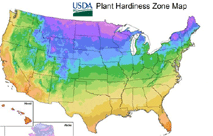Fig trees are "southern" plants, but now you can find them growing in Boston. Gardeners and growers across the US are finding they can grow plants they never could before, because it’s much warmer now.
The Department of Agriculture (USDA) has confirmed that in its 2012 version of the Plant Hardiness Map, which has been updated for the first time since 1990.
The new map shifts much of the US one zone higher (5 degrees), bringing the majority of some states, such as Ohio, Nebraska and Texas, into new, higher temperature zones.

The 1990 map was based on temperatures from 1974-1986; the updated 2012 map covers 1976-2005. Average temperatures in the US are now two-thirds of a degree higher, according to the National Climatic Data Center.
The trend toward warmer temperatures is "part and parcel of climate change," David Wolfe, a plant and soil scientist at Cornell University, told the Associated Press.
Without cold winters, pests are able to survive year-round, decimating crops, forests, and affecting peoples’ health, because populations of lyme ticks and other disease-carrying insects never die off.
On the positive side, it allows growers to produce crops they never could before. In New York, for example, the local wine industry can grow a greater variety of grapes.
"People who grow plants are well aware of the fact that temperatures have gotten more mild throughout the year, particularly in the wintertime," Boston University biology professor Richard Primack told Associated Press. "There’s a lot of things you can grow now that you couldn’t grow before."
He showed off a giant fig tree in his suburban Boston yard as an example: "People don’t think of figs as a crop you can grow in the Boston area. You can do it now."
"It’s great that the federal government is catching up with what the plants themselves have known for years: The globe is warming and it is greatly influencing plants (and animals)," Stanford University biology professor Terry Root said.
You can enter your zipcode at the new USDA map website to find your hardiness zone.
Here’s the map:
